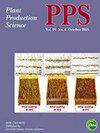Localized phosphorus application via P-dipping is more effective for improving initial rice growth in lower temperature conditions
IF 1.3
3区 农林科学
Q2 AGRONOMY
引用次数: 2
Abstract
ABSTRACT P-dipping is a practical approach for smallholder farmers to increase lowland rice yields with minimal fertilizer inputs by coating seedling roots with P-enriched slurry at transplanting. The effect of such localized application increases by concentrating more nutrients near the roots; however, this also increases the risk of salt stress known as fertilizer burning. The study aimed to identify the effect and burning risk of P-dipping on the initial rice growth under a range of temperatures. Rice seedlings were dipped instantly or for 2 h in slurry with different P2O5 concentrations at 0% (P0), 2.3% (P1), and 4.4% (P2), transplanted with the slurry attached to the seedling roots, and grown for 21–28 days at the day/night temperatures of 28°/20°C, 33°/25°C, and 36°/27°C. A significant interaction effect was detected between the P2O5 concentrations and growing temperatures on shoot biomass. With the P-dipping treatments, shoot biomass was increased 4.8–5.2 times at 28°/20°C. The effect of P-dipping became less significant with increasing temperatures because of the greater rates of withered leaves soon after transplanting. Burning damage was the greatest when the P2 treatment was combined with longer dipping duration at the 36°/27°C, nullifying the effect of P-dipping on shoot biomass. The results clearly showed that localized P application is more effective under lower temperatures, with lower risk of fertilizer burning. Elevated temperatures may disturb the effort to increase rice yields with minimal fertilizer inputs via localized application. GRAPHICAL ABSTRACT低温条件下,局部浸磷对水稻初期生长更有效
摘要:磷浸渍是一种实用的方法,对于小农户来说,通过在移栽时用富含磷的泥浆覆盖幼苗根部,以最小的肥料投入来提高低地水稻产量。这种局部施用的效果通过将更多的营养物质集中在根部附近而增加;然而,这也增加了被称为肥料燃烧的盐胁迫的风险。该研究旨在确定在一定温度下,浸磷对水稻初始生长的影响和燃烧风险。水稻幼苗立即浸泡或浸泡2 在不同P2O5浓度为0%(P0)、2.3%(P1)和4.4%(P2)的浆液中培养h,将浆液移植到幼苗根部,并生长21-28 昼夜温度分别为28°/20°C、33°/25°C和36°/27°C的天数。P2O5浓度和生长温度对地上部生物量有显著的交互作用。在28°/20°C下,浸磷处理使地上部生物量增加了4.8–5.2倍。随着温度的升高,P浸渍的效果变得不那么显著,因为移植后不久枯叶的比率更高。当P2处理与在36°/27°C下较长的浸渍时间相结合时,燃烧损伤最大,消除了P浸渍对地上部生物量的影响。结果清楚地表明,局部施磷在较低的温度下更有效,肥料燃烧的风险更低。气温升高可能会干扰通过局部施用以最少化肥投入提高水稻产量的努力。图形摘要
本文章由计算机程序翻译,如有差异,请以英文原文为准。
求助全文
约1分钟内获得全文
求助全文
来源期刊

Plant Production Science
农林科学-农艺学
CiteScore
5.10
自引率
4.00%
发文量
27
审稿时长
>36 weeks
期刊介绍:
Plant Production Science publishes original research reports on field crops and resource plants, their production and related subjects, covering a wide range of sciences; physiology, biotechnology, morphology, ecology, cropping system, production technology and post harvest management. Studies on plant production with special attention to resource management and the environment are also welcome. Field surveys on cropping or farming system are also accepted. Articles with a background in other research areas such as soil science, meteorology, biometry, product process and plant protection will be accepted as long as they are significantly related to plant production.
 求助内容:
求助内容: 应助结果提醒方式:
应助结果提醒方式:


